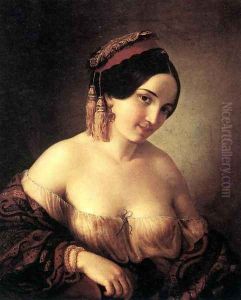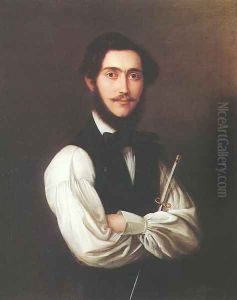Jakab Marastoni Paintings
Jakab Marastoni was a prominent figure in the 19th-century European art scene, known for his significant contributions to portrait and historical painting. Born in 1804 in Venice, Italy, Marastoni's early life was steeped in the rich artistic traditions of the Italian Renaissance, which influenced his development as an artist. Despite his Italian roots, Marastoni's career and legacy are most closely associated with Hungary, where he moved in the 1830s and became a central figure in the country's cultural life.
Marastoni's work is characterized by its meticulous attention to detail, vibrant color palette, and a keen sense of composition, reflecting the academic style of painting prevalent in his time. He was particularly adept at portraiture, capturing the likeness and personality of his subjects with precision and empathy. His portraits of Hungarian nobility and prominent figures of the era are celebrated for their elegance and realism.
Beyond portraiture, Marastoni also engaged with historical and biblical themes, imbuing his subjects with a dramatic intensity and emotional depth. His ability to blend the grandeur of history painting with the intimate detail of portraiture won him accolades and commissions from the highest echelons of Hungarian society.
Marastoni was not only a prolific artist but also a dedicated educator. In 1846, he founded a private art school in Pest (now part of Budapest), which became a pivotal institution for nurturing the next generation of Hungarian artists. His teaching philosophy emphasized the importance of classical art principles while encouraging individual creativity, making a lasting impact on the development of Hungarian art.
Jakab Marastoni passed away in 1860, leaving behind a rich legacy as an artist and teacher. His contributions to Hungarian art were instrumental in shaping the country's cultural identity in the 19th century. Today, Marastoni's works are held in high esteem, with many residing in the collections of Hungary's most prestigious museums, serving as a testament to his enduring influence on the art world.


